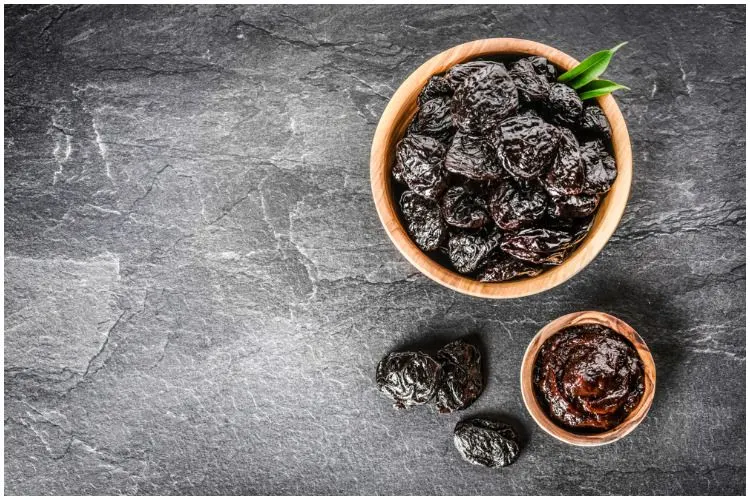Figs vs Prunes – Which Fruits Have A Better Nutritional Profile For Constipation? Also, are prunes and figs the same?
Introduction
Medically, constipation is defined as fewer than 3 stools per week.
Factors that may increase your risk of constipation include:
- getting little or no physical activity;
- eating a diet that is low in fiber;
- being dehydrated.
Here is a comparison of two dried fruits to eat when constipated:
Figs
Figs are the fruit of the ficus tree, which is part of the mulberry family.
They constitute an important part of the Mediterranean diet, either dried or fresh.
Originally from the Middle East and Western Asia, they are now grown in temperate climates around the world.
Prunes
A prune is a dried plum, usually the European variety of plum.
They are most popularly used for their laxative effects, however, a growing body of research concluded that dried plums offer substantial benefits for overall health.
READ MORE: Forchlorfenuron In Watermelon – Facts & Dangers
Nutrition Facts
100g of dried figs contain:
- 249 Calories;
- 9.8 g Fiber – 39% DV;
- 3.3g Protein – 7% DV;
- 1,2mg Vitamin C – 2% DV;
- 680 mg Potassium – 19% DV;
- 9mcg Folate – 2% DV;
- 0.5 mg Manganese – 26% DV;
- 0.1 mg Vitamin B6 – 5% DV;
- 0.1mg Riboflavin – 5% DV;
- 15.6 mcg Vitamin K – 19% DV;
- 0.4mg Pantothenic Acid – 4% DV;
- 0.1mg Thiamin – 6% DV;
- 2mg Iron – 11% DV;
- 68mg Magnesium – 17% DV;
- 67mg Phosphorus – 7% DV;
- 162 mg Calcium – 16% DV;
- 0.3mg Copper – 14% DV.
100g of prunes contain:
- 240 Calories;
- 7.1 g Fiber – 28% DV;
- 2.2g Protein – 4% DV;
- 0,6mg Vitamin C – 1% DV;
- 732 mg Potassium – 21% DV;
- 4mcg Folate – 1% DV;
- 0.3 mg Manganese – 15% DV;
- 0.2 mg Vitamin B6 – 10% DV;
- 0.2mg Riboflavin – 11% DV;
- 59.5 mcg Vitamin K – 74% DV;
- 0.4mg Pantothenic Acid – 4% DV;
- 0.1mg Thiamin – 3% DV;
- 0.9mg Iron – 5% DV;
- 41mg Magnesium – 10% DV;
- 69mg Phosphorus – 7% DV;
- 43mg Calcium – 4% DV;
- 0.3mg Copper – 14% DV.
Also, prunes contain high amounts of chlorogenic and neo-chlorogenic acids – phenols that have antioxidant functions.
READ MORE: Cream of Tartar (Potassium Hydrogen Tartrate) – Poisoning
Health Benefits
Figs
Diabetes
Diabetes is a group of diseases in which the human body doesn’t properly use the insulin which is produced, doesn’t produce enough or any insulin (peptide hormone produced by beta cells of the pancreatic islets), or exhibits a combination of both.
However, insulin resistance is the most common cause of type 2 diabetes mellitus. If the body is insulin resistant, it doesn’t use insulin properly.
The combination of lifestyle choices and genetic susceptibility leads to insulin resistance.
According to a 2003 study, figs can contribute to diabetes treatment by normalizing vitamin E and blood fatty acid levels as well as by improving insulin resistance.
READ MORE: Magnesium Taurate – Side Effects
LDL Cholesterol
Magnesium is an essential mineral that is used in hundreds of different biochemical reactions.
It is also used for the formation of our genetic material (RNA, DNA).
In some studies, the reduction of LDL and total cholesterol is quite substantial even with modest amounts of magnesium.
This is good news since elevated low-density lipoprotein cholesterol concentrations are strongly associated with coronary heart disease and atherogenesis.
100g of dried figs have 68.0 mg of Magnesium which is about 17 percent of the daily recommended intake.
READ MORE: Powerade vs Gatorade
Fiber
Dietary fiber is a non-digestible carbohydrate. It is divided into two categories based on its water solubility:
- Insoluble fiber – does not dissolve in water;
- Soluble fiber – dissolves in water and can be metabolized by the healthy bacteria in the large intestine.
A high-fiber diet may reduce the risk of kidney stones and gallstones, likely because of its capacity to help regulate blood sugar. Also, a high-fiber diet may lower the risk of developing small pouches and hemorrhoids.
Moreover, dietary fiber may help to slow your body’s breakdown of carbs and the absorption of sugar, helping with blood glucose control.
Women who increased their dietary fiber intake through diet notably reduced their caloric intake without their satiety and hunger scores changing, according to a study published in JAMA.
Additionally, individuals who ate the most fiber lowered their odds of cardiovascular disease by 18%, compared to people who consumed less than 19g per day, according to a 2017 analysis of 19 studies.
100g of dried figs have 9.8 g Fiber which is approximately 39 percent of the daily recommended intake.
READ MORE: Apple Cider Vinegar Enema – Side Effects
Manganese
Manganese is a trace mineral that is naturally found in whole grains, seeds, vegetables, and legumes.
This mineral helps to support healthy bone development, and contributes to tissue growth, and wound healing after injury.
Manganese also activates enzymes involved in removing toxic ammonia from the body and protecting the cells from physiological stress.
Other functions of this mineral in the body include:
- destroys free radicals;
- increases immunity;
- produces enzymes aiding digestion;
- balances hormone levels.
According to the data, over 33 percent of the world’s population is deficient in manganese, a condition that can have serious effects on human health.
100g of dried figs have 0.5 mg Manganese which is 26% of the daily recommended intake.
READ MORE: Foods High In Quercetin
Prunes
Vitamin K
This vitamin helps the human body to absorb calcium, and thus it is a vital aspect of bone health.
Also, it has an important role in proper blood coagulation, which prevents excessive bleeding.
100g of prunes have 59.5 mcg of vitamin K, which is 74% of the daily recommended intake.
Fiber
Fiber is a complex carbohydrate that the human body is not able to fully break down.
It actually passes through most of the body’s digestive system until it reaches the colon.
A high-fiber diet can help prevent constipation and significantly decrease the risk of hemorrhoids and colon cancer.
Additionally, some studies have established that even modest increases in dietary fiber intake help to lower blood sugar levels.
Another advantage of adding more fiber to your diet is that it makes you feel “fuller” longer, increasing your chance for weight-loss success.
100g of prunes have 7.1 g Fiber which is 28 percent of the daily recommended intake.
Potassium
Potassium is a mineral that is important for optimal human performance.
For instance, potassium helps the muscles work, including the muscles that control breathing and heartbeat.
Potassium also has a key role in maintaining the electrical conductivity of the brain.
A deficiency in potassium may lead to pain in the intestines, hypertension, and swelling in the glands.
100g of prunes has 732 mg of Potassium, which is about 21 percent of the daily recommended intake.
Vitamin C
Vitamin C is a water-soluble vitamin that is not stored in the human body.
Scientists have shown that daily consumption of 1000 mcg of vitamin C inhibits the production of histamines that are mainly responsible for suffocation in asthmatic suferrers.
Vitamin C also helps build healthy tissues, helps strengthen the immune system, and prevents oxidation-related damage.
In addition, vitamin C is a potent antioxidant that can have a big impact on vision.
Figs vs Prunes – Which Are Better For Constipation?
Figs and prunes have an amazing nutritional profile, but, regarding constipation, prunes are superior as they contain the laxative – diphenylisatin (also known as oxyphenisatin).
Moreover, a single prune contains more than 1g of sorbitol. It is a known fact that large amounts of sorbitol can cause diarrhea.
Images source – Shutterstock
READ MORE: Prunes vs Dates For Constipation
Sources https://www.fsu.edu/indexTOFStory.html?lead.plums https://www.scientificamerican.com/article/can-prunes-reverse-bone-loss/ https://www.tandfonline.com/doi/full/10.1080/13880209.2017.1285323 https://www.ncbi.nlm.nih.gov/pmc/articles/PMC5409740/
